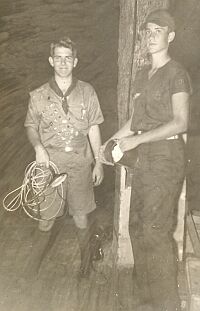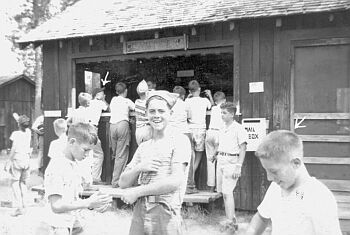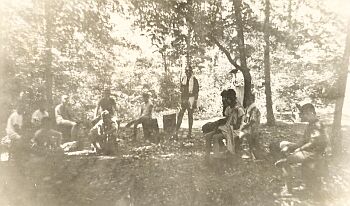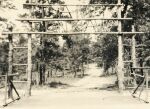 Tommy
Stewart said: "As a camper, I attended Tonkawa with
Troop 336 from Marvin Methodist Church in Tyler. We brought our own
tents, so we rode on top of the tents in an open stake bed truck to camp.
That way, a week at Tonkawa cost a boy no more that a gallon of gasoline
cost at 2007 prices. We tented by patrols; Robert Arms (Rosy) was
my patrol leader. Like Longview, there were "special activities"
for the neophyte. There was a boy named Bill in our tent who, like
me, was camping for the first time. He ended up going home due to
a sever case of homesickness. Some of the guys also found out that
poison ivy on the hands could spread to other areas of the body if those
areas were handled enough. <blush> Tommy
Stewart said: "As a camper, I attended Tonkawa with
Troop 336 from Marvin Methodist Church in Tyler. We brought our own
tents, so we rode on top of the tents in an open stake bed truck to camp.
That way, a week at Tonkawa cost a boy no more that a gallon of gasoline
cost at 2007 prices. We tented by patrols; Robert Arms (Rosy) was
my patrol leader. Like Longview, there were "special activities"
for the neophyte. There was a boy named Bill in our tent who, like
me, was camping for the first time. He ended up going home due to
a sever case of homesickness. Some of the guys also found out that
poison ivy on the hands could spread to other areas of the body if those
areas were handled enough. <blush>
"I was in Hogg Junior High
School, Tyler, Texas, when I first applied to be on the staff at Tonkawa;
I was 14 when accepted. F.M. Arnold informed me that I would need
to go to "school" to be the handicraft leader, so a bunch of us piled into
a 1950's Chevrolet and headed out. (see John Gummert's rememberance
below) We were instructed to NEVER drive OVER 50 MPH, but I can attest
that we never got UNDER 50 MPH while on the road. What an experience
we had at the Bear Creek Scout Camp. Not only did we hone our
skills as camp staffers, but we met Scouts from all over the state, maybe
even some outside of Texas.
"As a Staff member, we
each got one night off every other week, and a District Director would
take us into town. I remember one night we were going into Garrison
(they had a movie house back then) riding in a Studebaker, one of the models
in which the front and rear looked almost alike. There was probably
8-9 of us piled into the car, and we dared the driver to double the posted
recommended speed in each curve (those Studebakers were hot). He
did...a teen age boys dream come true. We did not have NASCAR or
TV in those days!
"When the Longview troop
was in camp, Johnny Case, the famous East Texas restaurateur, would provide
the food for the scout leader's social after taps; I think it was on Thursday
night after the campfire. He would bring all sorts of prepared seafood,
and for the adult leaders only, "special" libations. The staff really
looked forward to Longview being in camp so we would not have to eat the
big chunks of "surplus" cheese, bologna, and saltines.
Working the First Aid
Hut had its interesting moments. It was not unusual to sew up open
wounds, and the next day to take the boy into Garrison for the physician
to check the sewing job and to give him a tetanus shot. The worst
wound I closed was a scalp wound from a diving board accident. It
was after that accident the diving boards were removed from the swimming
area. There were many blisters, splinters, and boils to treat, and
even one case of getting a guys "private parts" disentangled from his zipper.
<ouch>
"Mrs. Nix, head cook while
I was commissary officer, and her crew from Mt. Enterprise really knew
how to cook good old East Texas country food. We got surplus butter,
so her bread pudding was afloat in the heavenly cholesterol that most of
us try to avoid nowadays. The wonderful fired chicken and French
fries on Sunday night were cook in MFB, a product that was very stable
at the high temperature of the propane-fired deep fat fryers, but it was
probably 100% trans fat. Just in the past year or so most American
fast food chains stopped using it, and fried foods will never be the same.
"What did Scouting mean
to me? It was the bases for what I am today. I learned how
to have healthy friends, how to do things for others, and at the same time
develop myself. I had polio as a kid, but I was never put down for
the way I walked, for the lack of my sports ability, or shunned by lack
of friendship. Scouting has changed. I wish it could be available
for every boy like it was for us at Tonkawa and in the East Texas
Area Council in those days."
Tommy Stewart
Baton Rouge, LA USA
Scott Smith said "As a member
of the waterfront staff from 1659-1962 I can report a number of details.
At that time I was known as Scotty Smith. Each member of the staff
had a slice of a log with their name painted on it, Mine was 6” in diameter
and 2 inches thick painted red with a white life ring and rope painted
on it along with my name. I remember how the campers would race to
the table where these were kept as they were setting their table for the
meal. They would fight over whose log they got because that staff
member would sit at their table for the meal. It seemed that the
waterfront staff was the most popular, probably because we were with them
longer than anyone else on staff. We tested every camper and scoutmaster
on Sunday afternoon when they arrived at camp and they all swam 2 hours
a day and many were there 2 more hours for merit badge work in canoeing,
rowing, and lifesaving.
"The training received was
intense and effective. All lifeguards had to be certified as a scout
lifeguard and a Red Cross Water Safety Instructor. The waterfront was the
safest place at the camp. We never came close to having a safety issue
on the waterfront in my four years at Tonkawa. We used the buddy
system, we allowed no foolish behavior and took our work very seriously.
We taught hundreds of scouts each summer to swim, row and canoe.
We also had one of the toughest lifesaving courses around. Anyone
who passed it was qualified to do lifeguard work anywhere. When we
were being saved in training, we fought to simulate a drowning victim and
we pulled our knees up to our chest to make ourselves sink when being pulled
to shore.
"Every Saturday morning
after the mile swim we placed Copper Sulfate crystals in a burlap bag at
the mouth of the spring. This helped to keep down the algae and plant
growth which contributed to some campers getting swimmer’s ear. We
put a cap full of alcohol in each swimmer’s ear at the end of each swim
and followed that with a medicine dropper full of olive oil. This
was my first job and the one I think about more often than any. It
was a great training ground for the real world."
John Gumert said "I first
went to Camp Tonkawa in the summer of 1947, a 12-year-old new scout, with
Troop 252, sponsored by the Kilgore Rotary Club. Like all newcomers,
I was dazzled by the cold water, the check-in physical exam for hernia,
and the camp food.
"I went to camp with the
troop every year until 1951. In May, that year, as a 16-year-old, I was
selected to attend National Camp and Aquatic School with the promise that
if I completed the Aquatic School I would be hired onto the camp staff.
I, along with Robert “Rosy” Arms (Tyler), Bill Carrell (Pine Tree), Al
Stoddard (Garrison),Tommy Stewart (Tyler) and Jimmy Newman (Tyler), attended
the school, sponsored by the National Council at Bear Creek Scout Camp,
Ingram, Texas. Now retired, I live about ½ mile from the former
Bear Creek Camp. We all passed our courses, and the next week began
our assigned duties at Camp Tonkawa. I was the Waterfront Director, with
Arms and Carrell on the staff. Stoddard ran the archery range, Newman the
rifle range, and Stewart, the handicraft program.
"I returned in 1952 ,
with Arms and Carrell and Bob Cargill (Longview) on the waterfront. I skipped
1953 for a real job in the oil field and Arms took over as Director.
In 1954, I was back as Waterfront Director, my last year at Tonkawa .
"I remember well
the “washing of the pots” after each meal, with each scout having an official
mess kit to eat out of. During my tenure, we had not yet gone
to a central dining hall, but for the 1952 year, we did have the new staff
dining hall and shower/toilets.
"The waterfront staff
was in charge of the “lighting of the campfires” on Sunday and Thursday
(stunt night) nights. On Sunday, it was a solemn event, with total
darkness and then the two “Indians” in the canoe moving up the creek with
a lighted torch to light the campfire. On Thursday night the same
ceremony was staged, but this time the “Indians” sank the canoe before
lighting the fire, which caused a great effect. During my time at
camp, we tried various other means to light the Sunday night fire, flaming
arrows on wires, strings tied to matches to start the flame from a distance,
but nothing was as good as the old canoe.
"The weekend after camp
closed in late July, the Order of the Arrow held its annual ceremonies,
beginning at noon Saturday. This gave us the manpower to move the
canoes, rowboats and diving boards up to the lodge for the winter.
"We had strict rules at
the waterfront. Every scout had a round tag which indicated his classification:
non-swimmer, beginner, swimmer, which hung on the board.
"A swimmer checked in
by moving his tag from the “out” section of the board into the “in” section.
If a swimmer forgot to remove his tag as he left the pond, this was noted
and an emergency situation began, with sweep of the pool and a call to
headquarters on a little one-wire line to try to find the missing scout.
Generally, the camp bugler got the call on top and would run to wherever
the troop of the missing scout was scheduled to be to see if he was really
there, or in the bottom of the pond. Throughout my tenure, all of
the scouts were found up the hill without a problem. The careless scout
who failed to check out was penalized by not getting his free swim period
for a day or so.
"On Saturday morning,
we held the Swim Meet with all troops participating. This was a spirited
competition with events for all three classes of swimmers, and we included
a diving competition. We had two 3-meter diving boards on the deep
end of the pond. We did have a couple of serious accidents on the
diving boards, and boards were removed after 1954.
"After lunch of sandwiches
on Saturday, the final ceremony was held, and merit badges and ribbons
were handed out to the troops. Staff was dismissed until noon the
next day (Sunday), and we all went home, usually with a hometown troop.
"Wednesday night’s meal
was always designated as “Wimpy” night, and hamburgers and chips served.
Thursday night was visitors’ night with families bringing “real food” to
the “starved” campers. This was followed by Stunt Night, and most
troops spent a lot of time and brought props to make their presentation
the best.
"Nearly every week, we
had a presentation by Winchester Arms Corporation on shooting safety.
At the campfire arena, a professional demonstrated the use of firearms,
with the grand finale being selected members of the audience shooting shotguns
at fruit and vegetables thrown into the air over the non-swimmers pool
area. The waterfront staff then spent the next hour removing the
junk food from the pond.
"Camp Tonkawa was a great
experience. Robert Arms, Jimmy Newman and I went on to graduate from
Texas A&M. Occasionally, we keep in touch through A&M reunions.
"My brother, Bill Gumert
, probably has told you of his tour at camp as canteen manager. You
remember the rule that if a scout dropped a Coke bottle or candy wrapper
on the ground, another scout, if he were quick enough, could pick it up
and demand the offending scout buy him one of the same Coke or candy.
This was effective in keeping the camp clean of litter."
Pete Velde said “Summer camp
at Camp Tonkawa was one of the highlights of the year. Along with
getting away from home for a week, it gave our Troop the chance to camp
with other Troops in the region. At Tonkawa we got to do archery,
shoot at the rifle range, swim every day in the warm 54 degree spring water,
do canoeing and rowing , take nature hikes, and compete with the other
Troops at campfires."
 Velde
continued, "We would all eat in the dining hall, pick up our mail, have
a drink at the canteen, and have assemblies at the main lodge." Photo
at left shows the canteen in 1948. Arrow on left points to Robert
Cargill, Jr. and arrow on right points to John Head. Velde
continued, "We would all eat in the dining hall, pick up our mail, have
a drink at the canteen, and have assemblies at the main lodge." Photo
at left shows the canteen in 1948. Arrow on left points to Robert
Cargill, Jr. and arrow on right points to John Head.
Kenneth Raney said “My group
was the last to spend summer camp at Tonkawa. Either summer 1963
or summer 1964, East Texas Area Council opened the new George W. Pirtle
Scout Reservation near Carthage, Texas. I loved them both.
I loved Tonkawa because of its spring-fed lake – getting a mile swim patch
in that water was an event. Tonkawa was older, but was quainter.
"I remember the visit to
the 7 Sisters – 7 pine trees that it would take 12 Scouts arm to arm to
go around the base. The denseness of the woods provided a better
backdrop for the OA tapout. I remember Ben Cominsky as a counselor
– he even looked like a real Indian. “
 Robert
Cargill, Jr. remembers "Meals were prepared in a central
kitchen under the watchful eye off. F. M. (Hoss) Arnold. A crew of four
or five boys would be sent to camp headquarters with a two-man carrier
on which to bring cooked food back to the troop's campsite. The extra boys
carried items that wouldn't fit. Occasionally, there would be an accident
and some, or all, of the food would end up in Tonkawa sand. Near
the end of the week was Family Day, when parents could come visit and we’d
usually have realized by that time that the comforts of home were not that
bad after all. Tonkawa memories will always be there - of the wooded
hills with white sandy trails, the smell of wood smoke, the echoes of other
Scouts in distant campsites, listening to Taps every night and waking to
Reveille in the cool, damp mornings.” Robert
Cargill, Jr. remembers "Meals were prepared in a central
kitchen under the watchful eye off. F. M. (Hoss) Arnold. A crew of four
or five boys would be sent to camp headquarters with a two-man carrier
on which to bring cooked food back to the troop's campsite. The extra boys
carried items that wouldn't fit. Occasionally, there would be an accident
and some, or all, of the food would end up in Tonkawa sand. Near
the end of the week was Family Day, when parents could come visit and we’d
usually have realized by that time that the comforts of home were not that
bad after all. Tonkawa memories will always be there - of the wooded
hills with white sandy trails, the smell of wood smoke, the echoes of other
Scouts in distant campsites, listening to Taps every night and waking to
Reveille in the cool, damp mornings.”
Jimmy Horne, Staff from 1958-61,
said that "A horseshoe and a block of wood were tied together and were
used in teaching the Life Savings skills. The instructor would throw
this device into the deep water and the trainee would search the bottom
until they found it."
Eddie Goldsberry said that
"The water was really, really cold..... But it was better than the pool
at the Methodist church camp near Palestine which turned everyone's hair
green. I did in fact attend Tonkawa a few times, three I think.
Not sure about the dates, but probably about 1959 or '60 to about 1961
or '62."
 Robert
Cargill, Jr. remembers “Summer camp at Camp Tonkawa, near
Garrison, Texas, was something to which I looked forward. During my first
encampment, I was a hopelessly poor swimmer, and the icy waters of the
Tonkawa pool always took my breath. I was sent to the Quartermaster for
the key to the flagpole and for a sky hook with which to erect a tent.
" Robert
Cargill, Jr. remembers “Summer camp at Camp Tonkawa, near
Garrison, Texas, was something to which I looked forward. During my first
encampment, I was a hopelessly poor swimmer, and the icy waters of the
Tonkawa pool always took my breath. I was sent to the Quartermaster for
the key to the flagpole and for a sky hook with which to erect a tent.
"
Jesse Case: Year round
Grounds Keeper/Ranger deceased....a really nice guy and was Mr. Tonkawa
himself. He is buried at Walnut Gove Church just down from Tonkawa
on 1087. His nephew Emmett Case, said his Uncle would make him open
the little round door and clean the sand out of the concrete tile which
is part of the head waters of the Naconiche Creek.
KYOB is what the Tonkawa
people called the outdoor latrines. It means Keep Your Bowels Open.
Sherry Lovell, Nacogdoches
Chamber of Commerce, who owns property in the vicinity of the former Camp
Tonkawa, said that Camp Tonkawa Spring is known as the Tucker Branch of
the Naconiche Creek. The Naconiche Creek (Naconiche Bayou) was named
for the Naconiche Indians, a Caddoan group that originally inhabited the
area.
According to Jesse Case's
Nephew, Emmett Case, there is a 1,000 acre lake being
built in the area and the Naconiche Creek will flow into this new lake
to be called Lake Naconiche which will be the most southern point on the
North American Continent that trout can survive year round.
Russell Turbyfill, Waterfront
Staff Administrator 1944 says he remembers John Arnold when he was a little
tike ...Mr. J. C. Underwood, the Camp Director chewed them out plenty well
for the footprints on the ceiling....we couldn't have found you without
them Russell, we are literally following in your footprints...you left
an enduring trail.
Whitten, 1949, whose head
bent the bow of a rowboat and Glynn Rhame was the one who sewed him up
according to Bill Stephenson.
Bug Juice: Bug Juice
was a powerful drink that was consumed at nearly every meal while at Camp
Tonkawa and is still served at most Boy Scout camps. It was always,
as far as James Powers Branch remembers. served in an aluminum pitcher.
It consisted of sugar, water and Kool Aid or similar product. It
was one of the reasons why the Scouts and leaders were so handsome, wealthy
and wise, it was a delightful flavorful drink....magic powers....made from
water taken from the Tucker Spring, one of the Headqaters of the Naconiche
Creek, located at Camp Tonkawa.
Two cannon balls, a one
inch and a two inch, have been found fairly recently on the Tonkawa property
and Nacogdoches being only 12 miles away, they probably played a part in
the Texas Revolution. They are available for you perusal upon entering
the office at Camp Tonkawa Spring Resort.
From the 1956 Staff Guide
Book:
The "Black
Panther" Week ....
That first
Sunday campfire when the firestarter was yanked outside the fire ....
The felling
of the pines from Staff Row and the hole they left in the sky .....
Those FORMAL
tent inspections ....
When the
torches went out during the O.A. ceremony ....
The waterfront
crew getting lost on the way to Aqua Fria ....
Staff Band
knowing no encores ....
The Royal
Order of Siam ....
The "Menagerie
Tent" on Visitors Night....
The Batmitton
games....
We are looking for additional
"remembrances" about Camp Tonkawa. If you have any to relate please
send them to the webmaster found at the bottom of the home page.
| Home | Facilities
| Program | Waterfront
| Campsite | Camp Songs
| Patches |
| Neckerchiefs | Maps
| Staff | Promotion
| Other Photos |
Some of these remembrances
were taken from A History of Troop 1 (201) Longview, Texas 1917
- 2002, by Paul A. Yater, 2002 and James Dixon Graves, Jr. list of
camp staff. Also John Gumert, formerly of Troop 252, Kilgore.
Last Updated: July
1, 2012
|

